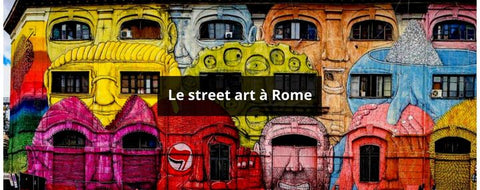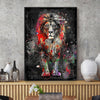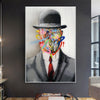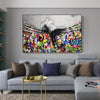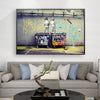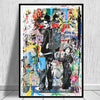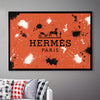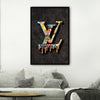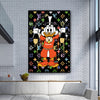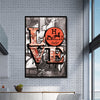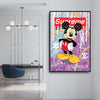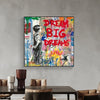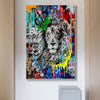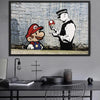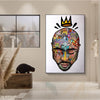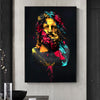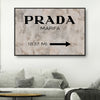
Street Art in Rome
Are you visiting Rome or would you like to get to know it better? This city, rich in Roman ruins and steeped in history, is loved by tourists from all over the world for many reasons. Between the Vatican, the Colosseum, Borromini's architectural masterpieces, and Caravaggio's paintings, there's so much to see. However, did you know that the Eternal City is now one of the top destinations for street art ? As art enthusiasts, we've been interested in it for years and know a lot about it. In this article, we'll introduce you to:
- How did street art develop in Rome?
- Which neighborhoods showcase it?
- What styles can you find there?
- What themes are addressed by Roman street artists?
- In what manifestations do they express their art?
- The prospects for this discipline in the Italian capital
As you read on, you'll become a true expert on Rome's street art . So, let's get started without further ado!

I) History of street art in Rome
Considered a contemporary movement encompassing all forms of art created in the street and in public spaces, urban art is now almost everywhere. Street art has been present in Rome for several decades, and here is its story.
1) Evolution of street art in Rome
World War II created a brutal rupture in art, leading to a diversification of the media used. Street art was thus born in the United States during the 1970s, before reaching Europe in the 1980s. During this period, graffiti artists proliferated in the streets of Rome, even exhibiting their work in museums and art galleries. However, the true history of street art in Rome only really begins in the 2000s, with the launch of The Big City Life Project, a project to rehabilitate the city's neglected or peripheral neighborhoods.

Since then, two museums dedicated to contemporary art have opened: theMAXXI and the Macro. They will be followed by numerous galleries, such as Unosunove, Ermanno Tedeschi, and Lorcan O'Neill Rome. Urban art is developing off the beaten path, in working-class neighborhoods and outside the city center. It continues its momentum, offering local residents and visitors the opportunity to appreciate the meaningful works of many talented artists.
In practical terms, Rome is one of the cities that allows urban art to flourish. Rome thus enables artists of this genre to bring art to the streets and revitalize neighborhoods. As a result, areas that were once rather drab are now gaining modernity and color. Numerous works adorn the facades of abandoned and industrial buildings, warehouses, and concrete fences. Street art is also spreading to schools, metro stations, and other institutions.

2) Famous street artists of Rome
Street artists in Rome are particularly numerous. The movement was initiated by big names such as Jannis Kounellis, an internationally renowned figure of Arte Povera. It then gained popularity thanks to the works of talented individuals like Luigi Ontani , Alessandro Piangiamore, Elisabetta Benassi , and Claudio Abate . Joining them is the artist duo Sten Lex, pioneers of urban stencil art in Italy.
Today, the new generation of painters numbers in the dozens. Lek and Sowat, Seth, Jaz, Domenico Romeo, Satone, Mr. Klevra, Jerico … all express their passions on Rome's infrastructure. Not forgetting the great local and international urban artists: C215, Jef Aerosol, ROA, Borondo, Alicè, Clare Rojas, JR, Shepard Fairey, Invader, Blu, Miss Van, Banksy …

III. Neighborhoods where you can find street art in Rome
The street art that adorns Rome has transformed it into a veritable open-air museum . It enjoys a strong visual impact throughout its various neighborhoods. Here are the locations where you can admire these murals by renowned artists.
A. San Lorenzo district, birthplace of Roman street art
San Lorenzo is renowned as one of Rome's artistic neighborhoods . It boasts a variety of street art, including the collective murals on Via degli Ausoni , Via degli Enotri, and Via dei Volsci. Also worth seeing is Luca Maleonte's mural between Via dei Piceni and Via dei Reti, which commemorates the victims of the bombings that devastated the neighborhood during World War II.
However, San Lorenzo street art also boasts some of the finest pop art paintings by Francesco Persichella. They adorn the top of a disused basketball court on Via Dello Scalo di San Lorenzo. As you explore the neighborhood, you'll undoubtedly discover other masterpieces. Alice Pasquini, Leonardo Crudi, Unga, SOLO, Christian Ghémy, and other artists from diverse backgrounds are breathing new life into local infrastructure.

2) Pigneto district
Pigneto was long an industrial area. Today, it's a trendy neighborhood still relatively untouched by mass tourism. Street art has taken root here, thanks to works like the painting of a couple in a tender embrace, signed Sten & Lex. This painting is, in fact, the reason for the neighborhood's nickname , "House of Stencils." Other Pigneto street art creations are more specifically linked to film and literature. This is the case, for example, with the black and white representation on Via Fanfulla da Lodi. This work by Maupal highlights Pier Paolo Pasolini's piercing gaze. You'll also be amazed by Mirko Montana's rendering of "Non Illuderti" on Via del Pigneto. And, heading towards Tor Pignattara, you'll catch a glimpse of "Coffee Break" by Etam Cru, the tallest mural in the city.
3) Ostiense Quarter
Formerly an industrial district, Ostiense is now one of Rome's most interesting and vibrant areas. Besides its numerous pubs, museums, and restaurants, this district boasts over thirty murals by renowned international artists. These works blend seamlessly into the building facades and the local cultural heritage. Ostiense street art includes "Hunting Pollution" by Federico Massa, considered the largest eco-mural on the continent. It also features "Jumping Wolf" by ROA on Via Galvani and the mural surrounding the Alexis social centerby the urban artist Blu .
4) Tor Marancia district
Street art enthusiasts can't visit Rome without exploring and photographing the Tor Marancia neighborhood. And rightly so, since this is the area where the participatory urban art project Big City Life took place. It has been completely transformed thanks to street art. For example, nearly 11 buildings on Via di Tor Marancia now boast murals by exceptional artists. Almost 22 works have breathed new life into these local structures.

5) Quadraro District
Quadraro is a perfect example of Rome's street art scene . Starting from Via Tuscolana, you can discover "il MURO," a free, open-air street art museum. There, you'll find David Vecchiato's work, "Art Pollnates Quadraro," on Via dei Lentuli. Your artistic journey can then continue with Lucamelonte's "Nido di Vespe" and M.Toms's "Giant Monster." And why not check out Ron English's "Baby Hulk" on Via dei Pisoni?
1) Street art styles in Rome
Urban art manifests itself in several styles in Rome's neighborhoods. Italian and international artists who have left their mark on the city employ a wide variety of techniques. The only limit to street art styles in Rome is their imagination.

1) Traditional graffiti
A relatively old form of expression,graffiti differs from tagging (a simple signature). It consists of conveying a genuine message on walls through artistic representation. Traditional graffiti in Rome also covers train carriages and subway stations. Graffiti artists work with diverse shapes, colors, and styles. Graffiti becomes a true tool of expression. The works are largely created freehand with spray paint. However, street art means that this method is now combined with other techniques and mediums. This is one of the reasons why this art is considered "neo-graffiti" or "post-graffiti."
II) Stencils
Emerging in the early 1980s, stencils are a highly popular artistic expression technique. These works differ from classic Roman graffiti in their style and method of creation. The artist creates a design on a rigid material using a stencil. This can be a metal, plastic, cardboard, wood, or other material. The stencil is then used to hold paint or spray paint. This process allows for the quick and easy reproduction of a mural in multiple copies. Roman stencils are works of art with a clear, precise, and impactful message. They are created by renowned artists such as Banksy, EZK, Jef Aerosol, and Blek le Rat.
III) The facilities
Street installations are an increasingly popular technique in urban art. Unlike conventional graffiti adorning walls and surfaces, they involve the use of sculptures and/or 3D objects. Artists also play with space to interfere with, interact with, and enhance the urban environment. Street art installations in Rome offer people the opportunity to reflect and question. Indeed, their purpose is to challenge or even shock by disrupting the cityscape. Furthermore, they cause no damage to the intended location.

4) Themes addressed by street art in Rome
Street art themes in Rome are quite diverse. Through their works, artists convey messages that are sometimes unsettling, provocative, or dark, or sometimes funny or lighthearted. They radically change the public's relationship with the city.
I) Politics and Roman street art
In Italy, as throughout the world, street art is used to denounce society or convey a strong political message. The works are considered a form of public art when the artists have obtained permission. Political street art in Rome is a theme explored not only in urban landscapes but also in local galleries and museums. This art allows graffiti artists to raise difficult questions and express political concerns. It's a way to share their perspective on a specific current event. Of course, all of this is done in the interest of urban beautification.
III) Religion denounced by the urban art of Rome
From large murals spanning thirty meters to small signatures and intricate stencils, urban art employs an unparalleled range of techniques and styles. These works are made to be displayed in the street. The public may ignore them, judge them, hate them, or love them. Designed to provoke and fascinate, these artistic creations are likely to address sensitive subjects such as religion. They represent a contemporary form of expression denouncing commercial excesses, certainty, and dogmatism.

3) Culture
Street art offers a multifaceted form of cultural expression. It allows artists to paint for decoration. This distinctive decorative style is found both on cityscapes and in paintings used to embellish interiors. Highly colorful, these works prompt reflection on various cultural themes, ranging from consumer society to mass society. Street art in Rome also addresses notions of justice and peace, as well as issues such as combating climate change and reducing inequality on various levels.
VI. Street art events in Rome
Street art fans have the opportunity to participate in various events dedicated to this art form in several neighborhoods of Rome. These take the form of festivals and exhibitions held on several dates throughout the year or annually.

I) Street art festivals in Rome
In the category of street art festivals in Rome , the EPART Festival is among the most popular events for enthusiasts. It was at this event, in collaboration with the Ecomuseo Casilino, that the artist Tellas found the inspiration to create his work "Mimesi." This mural evokes the vast Roman vegetation of yesteryear. The Street Art for Rights festival, focused on sustainable development, is also a must-see. Seventeen murals will be exhibited for its third edition to highlight the United Nations' 2030 Agenda. And let's not forget the FAME festival and the Big City Life festival.
II) Street art exhibitions in the Italian capital
Rome's street art scene is less renowned than those of Berlin, London, or Los Angeles. However, the number of exhibitions continues to grow year after year. Various events are organized to showcase emerging artists. You'll discover their work in local tourist centers. It's also accessible in various dedicated galleries. MondoPop Gallery, MARteGallery, and MAXXI are perfect examples. Keep an eye out for exceptional exhibitions, such as "StenLex: Rinascita," a collaboration between the Modern Art Gallery of Rome and the Wunderkammern Gallery.
6) The future of street art in Rome
It took only a few years for the walls of Rome to be transformed into an open-air museum. Consider also the fact that events surrounding this discipline are developing rapidly. The question then arises: does Roman urban art have a real future?
1) The challenges facing street art in Rome
The preservation of street art in Rome is a concern for all urban art fans. While its growth is unprecedented, this movement faces numerous challenges. One of them is ensuring that artists can continue to produce works that allow them to share and connect their art with local residents.
Another approach involves promoting the establishment of street artist collectives. These are groups that can include a wide range of people, from graffiti artists and designers to painters, stencil artists, and photographers. These individuals will work together on a specific mission: defending a pre-established cause (fighting oppression, contempt, injustice, etc.). A significant challenge is also to overcome artists' apprehensions. Some avoid being recognized as "street artists" due to the rise of institutionalized urban art.

II) Opportunities for street art in Rome
Urban art continues its expansion in the streets of Rome. A significant evolution of street art in Rome is therefore expected in the months and years to come. Murals and other works of this kind are a crucial attraction for local tourism. Many visits to the city involve exploring the streets and open-air art galleries. Their presence enhances neighborhoods, makes them more popular, and improves the quality of life for residents. Furthermore, immersing oneself in street art also offers the opportunity for culinary adventures. Newly established trattorias and bars will be able to offer the delights of Roman and Italian cuisine to visiting urban art enthusiasts , thus boosting the local economy.
Street art in Rome now holds no secrets for you. You can start planning your next trip now or choose pieces of this style to brighten up your interior décor. Decorate your living room, bedroom, or entryway with style. We invite you to browse our most popular collections to find the perfectstreet art decorating idea.
To thank you for making it this far, enjoy a 15% discount on your order today with the promo code: BLOG15 .
See you soon.
The Lofty Trend Team.







